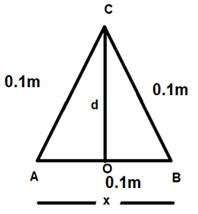Consider a 10 cm long piece of a wire which carries a current of 10A. Find the magnitude of the magnetic field due to the piece at a point which makes an equilateral triangle with the ends of the piece.
Given:
Length of the wire piece: x = 10 cm = 0.1 m
Current in the wire piece: i= 10 A
Formula used:
By Biot-Savart Law:![]() Here, dB is the magnitude of magnetic field element, μ0 is the permeability of free space and μ0= 4π × 10-7 T mA-1,dl is the length element, r is the distance between the current carrying wire and the required point.
Here, dB is the magnitude of magnetic field element, μ0 is the permeability of free space and μ0= 4π × 10-7 T mA-1,dl is the length element, r is the distance between the current carrying wire and the required point.
We know that, magnetic field at a point on the perpendicular bisector is![]() Here, x is the length of the wire.
Here, x is the length of the wire.
d is the distance between point C and the midpoint O.
From Pythagoras theorem,
(BC)2 = (OB)2+(OC)2
∴ (OC)2 = (BC)2 - (OB)2
∴ (OC)2 = (0.1)2 – (0.05)2
∴ OC = (7.5× 10-3)1/2
∴ OC = 0.086 m = d
Substituting for B we get,
∴ B = 2.32× 10-5 × 0.502
∴ B = 1.16 × 10-5 T
Hence the magnitude of the magnetic field due to the piece at a point which makes an equilateral triangle with the ends of the piece is 1.16 × 10-5 T.